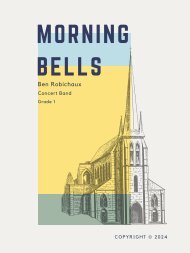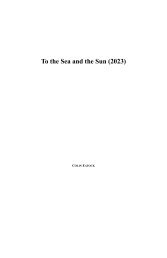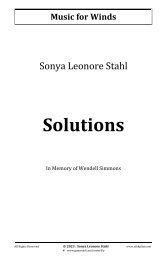Create successful ePaper yourself
Turn your PDF publications into a flip-book with our unique Google optimized e-Paper software.
INSTRUCTIONS:<br />
Notes on soloist selection:<br />
The singer should have extensive experience in pop, folk, or jazz performance. While it would be preferable for the singer<br />
to have the ability to read standard musical notation, it is not completely necessary, and can be performed by any singer<br />
with a strong sense of pitch and rhythm. It is preferred that the sung texts are not performed in an operatic style, and the<br />
sung texts must be performed through amplification for both sound quality and ability to be heard over the ensemble. A<br />
“high voice” version of the singer part is available, with some range modifications of the original part.<br />
The two emcees (rappers) for “<strong>Passages</strong>” should have some experience in performing alternative or experimental hiphop,<br />
ideally including some music that is not in 4/4. Lyrically, they must write new, original lyrics, specific to “<strong>Passages</strong>”,<br />
following the emcee prompts printed on the lyrics page. Before the first rehearsal, the emcees should create a demo of the<br />
planned performance, aligned using a DAW with the backing tracks provided in the digital MC chart. “<strong>Passages</strong>” may be<br />
performed by one soloist, rather than two, and a “one-emcee version” chart is available, containing instructions for an<br />
effective performance. The emcees are encouraged to have complete freedom in the creation of their lyrical content, and<br />
may suggest alternate entrances and exits from the ones notated in the score.<br />
The instrumental jazz soloist should have some ability to read chord charts and improvise in a virtuosic bebop style.<br />
Strong reading ability in notated music is not necessary, and preference should be given to improvisational style. It is<br />
preferred that this soloist is an alto or tenor saxophonist, for timbral reasons, but another wind instrument may be used.<br />
Soloists can be provided by ShoutHouse. For more information, write to them at shouthousenyc@gmail.com, or visit<br />
www.shouthousemusic.com. They are also able to offer consultation regarding emcee selection and mentorship during the<br />
rehearsal process to ensure a cohesive performance.<br />
Performance Notes:<br />
All accidentals carry through the measure. Accidentals do not carry through different octaves. All enharmonic spellings of<br />
notes are intended to aid in readability, which sometimes takes precedence over suggested harmonic context.<br />
If a player is unable to perform “slap-tongue” these notes may be substituted with a light staccato unless otherwise<br />
indicated.<br />
+ and o indications signify the use of alternate fingerings. The player is free to use any fingerings they choose, but wherever<br />
possible these notes should have a timbral or tuning difference from the standard fingering. The + and o markings do not<br />
refer to the standard or non-standard fingerings specifically, they are merely intended to show a change from one to the<br />
other.<br />
Feathered beaming: There is the extensive use of feathered beaming in the third movement. Whenever possible, the<br />
players should remain out of sync with one another, transitioning smoothly from held notes into rapid tremolos.<br />
Gradually increase tremolo speed<br />
Gradually decrease tremolo speed<br />
Decrease tremolo speed and<br />
smoothly transition into a held note<br />
The Double Bass part calls for extensive use of the low-C extension. If the player does not have an instrument with a low-C<br />
extension, it is preferred that they transpose full phrases up an octave, rather than single notes, in order to maintain the<br />
continuity of lines.<br />
Piano muting: In a few places, the pianist is asked to mute notes inside the instrument with one hand. If this is logistically<br />
difficult (some music desks and setups make this technique impossible to execute quickly), the pianist should leave these<br />
moments out rather than performing those notes.<br />
All Harp harmonics sound up one octave from their notated pitch.<br />
Drumset notation should be used as a guide throughout, the ideal drumset player for “<strong>Passages</strong>” has experience performing<br />
in classical, jazz, and popular genres. Particularly during emcee and soloist sections, the drumset player is encouraged to<br />
improvise, using the part as a guide.<br />
While the selection of singing bowls is left to the percussionists, the ideal singing bowls for the third movement are pitched<br />
to an E-natural, small, with a high, clear sound. If these specific singing bowls are not available, the percussionists may use<br />
any small singing bowls, struck with felt or suede mallets.

















